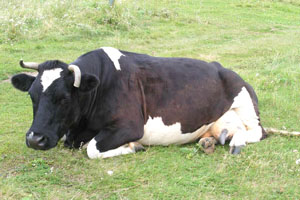Babesiosis in cattle: 10 interesting facts

Photo is illustrative in nature. From open sources.
Babesiosis is an infectious disease caused by parasites of the genus Babesia that infect the blood of mammals, including cattle ( cattle ). Here are 10 interesting facts about babesiosis in cattle:
1. Transmitted by ticks: Bovine babesiosis is transmitted through tick bites that carry parasites from the genus Babesia. This makes the disease common in areas where these ticks live.
2. Impact on MEAT and MILK production: Babesiosis can significantly reduce meat and milk production in infected animals, resulting in economic losses for farmers.
3. Symptoms in cattle: Symptoms of babesiosis in cattle may include fever, weakness, loss of appetite, pale mucous membranes and jaundice.
4. Diagnosis: To diagnose babesiosis in cattle, laboratory diagnostic methods such as blood smears and serological tests are usually used .
5. Treatment: Treatment of babesiosis in cattle may include the use of antiparasitic drugs such as imidocarb and diminazene.
6. Prevention: Prevention of babesiosis in cattle includes tick control, use of anti-tick medications and maintaining a good immune system in animals.
7. Distribution: Bovine babesiosis occurs in various parts of the world, including North America, Europe, Africa and Australia.
8. Impact on human HEALTH : Although babesiosis is not usually transmitted from cattle to humans, some species of parasites from the genus Babesia can cause disease in humans.
9. Research: Scientists around the world are actively working to develop new methods for diagnosing and treating babesiosis in cattle, as well as developing vaccines to prevent the disease.
10. Implications for agriculture: Control of babesiosis in cattle is of great importance for agriculture, since the disease can significantly reduce the production of livestock products.
Babesiosis in cattle is a serious problem for agricultural enterprises, and its study and control play an important role in ensuring animal health and sustainability of agricultural production.
Read together with it:
- В Приморье владельцу коз вынесено предупреждение за игнорирование ветеринарных мероприятийПо информации управления, владелица частного подворья, Чернуха Г.В., отказалась предоставить для осмотра и проведения ветеринарных процедур 14 коз. Согласно российскому законодательству, владельцы животных несут ответственность за их здоровье и обязаны проводить профилактические мероприятия, направленные на предупреждение болезней. В управляющем органе подчеркивают, что владельцы животных обязаны ...
- Compensation for moral damages, 4 years in prison. The perpetrator of a fatal accident near Gomel has been sentenced.September 30, Gomel. The Gomel District COURT issued a verdict in a criminal case regarding a traffic violation committed by a person driving a vehicle while intoxicated.A pedestrian was found guilty of driving while intoxicated , resulting in his death through negligence . This was reported to BELTA by the Gomel Regional Court. The defendant was charged under Part 4 of Article 317 of the Criminal...
- Аргентина: SENACSA усиливает национальную кампанию против бруцеллеза крупного рогатого скотаВ каждом пункте отбор проб проводится при содействии специалистов Фонда охраны здоровья животных (Fundasa), отдавая приоритет самкам, уже родившим. Первые результаты уже дают важную информацию о состоянии здоровья животных. «Бруцеллёз — эндемичное заболевание по всей стране, и мы должны это учитывать. Эта кампания направлена не только на выявление риска, но и на сокращение числа инфицированных ж...
- Новые технологии: Продление жизнеспособности спермы быков с помощью стволовых клетокИсследование показало, что применение лизата значительно улучшает сохранение жизнеспособности сперматозоидов, при этом после четырех часов наблюдалось 41% прогрессивно подвижных клеток и 62% морфологически нормальных. В отличие от этого, кондиционированная среда продемонстрировала менее эффективные результаты, сохранив жизнеспособность всего на два часа. Эти результаты открывают новые горизонты дл...
- Russian scientists have developed fluorescent probes for research in medicine and veterinary science.Specialists from Moscow, St. Petersburg, Yekaterinburg, and Chelyabinsk, with support from the Russian Science Foundation, developed a series of fluorescent probes. They explained that the probe is a tag molecule that can be inserted into a DNA strand for subsequent identification and tracking of changes. This innovative approach was achieved using 1,2,4-triazine methodology. The scientists also s...
- В посольстве сочли незаконной конфискацию Канадой российского самолетаВозможная односторонняя конфискация самолета Ан-124-100 российской авиакомпании «Волга-Днепр» в Торонто является незаконной и имеет явный антироссийский подтекст, заявили «РИА Новости» в посольстве России в Канаде. «Что касается возможности односторонней конфискации Канадой частной собственности, это с самого начала было откровенно политизированным делом с явно антироссийским подтекстом Таки.........


